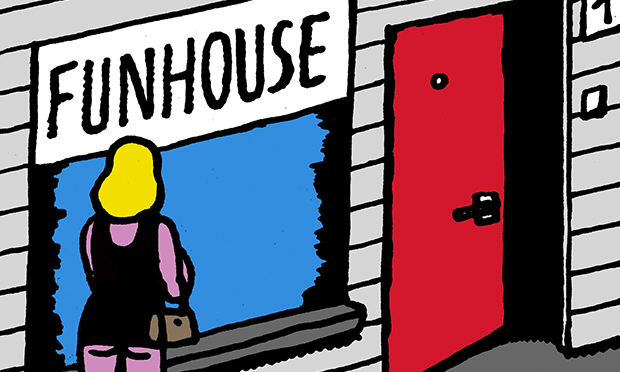
Funhouse is a new quarterly for young writers and illustrators, which is launching early this month. Founded by Hackney-based editor Oliver Zarandi and designer Fran Marchesi, the magazine will publish stories and illustrations that would be less likely to appear in the more established literary venues.
The first issue is concerned with the body, with a fittingly fleshy colour running throughout its 94 pages. Think not graceful nudes or svelte athletes; these bodies tend toward the grotesque, with many of the stories feeling their way into disease and bodily transformations. The illustrations feature a series of people castrating each other, being punched in the head, missing noses.
The mag’s contributors include writers such as Richard Barnett, author of The Sick Rose, Patty Cottrell, Jason Schwartz and East London based comic artist Alex Widdowson. The inaugural issue’s front cover is by Will Laren who frequently contributes to Vice.
Moving forward, the Funhouse team is hoping to attract more East London writers and illustrators for the next issue in the aim of creating a local literary community. I caught up with Zarandi a few weeks before the first issue was due to come out and asked him the magazine’s genesis.
Where did the idea for Funhouse come from?
Funhouse has been an idea for a long time, but only in the last nine months has it really come to life. The name comes from a story by John Barth – ‘Lost in the Funhouse’ – and there was one point where I actually contacted John Barth. I emailed the university he used to teach at and they put me in touch with him. He said it sounded “fine” and said I should talk to his agent. Obviously, there was no reply. The whole Barth thing made me change my mind. It made me think maybe I was doing something old-fashioned. Sometimes literature and ‘art’ magazines can be very off-putting – too serious, too much text, not enough focus on younger writers, or events where you watch people read long poems for hours on end. Fran Marchesi and I wanted to make a magazine of writing and illustration that was respectful to the artists but still has its tongue firmly in cheek. We wanted Funhouse to be a bit naughty and print work that was offbeat, dark and funny.
Why a magazine? We heard a rumour that ‘print is dead’.
To say print is dead is a bit of a limiting statement. It’s like saying novels are dead, theatre is dead or film is dead. I think the reason I chose print as opposed to something digital is out of respect for the writers. As a writer myself, I would always prefer to have something tangible, something special. A lot of writers have work online, but then maybe a year or two later that link is dead. Fran and I wanted to create something beautiful. There’s a lot of illustration in Funhouse too, so again, we want people to actually pick up this magazine, to feel it. There are a lot of great print magazines and publishers out there right now – places like Test Centre, And Other Stories, The Alarmist, Hexus – who are all creating great print work.
What were your inspirations and what direction do you hope to take the magazine in?
For our first issue, we’ve definitely taken a lot of inspiration from American literature and publishers. A particular influence is Tyrant Books and their editor Giancarlo DiTrapano, who published New York Tyrant and, eventually, Preparation for the Next Life by Atticus Lish. It is an amazing book and Di Trapano did it his way. I’ve got a lot of respect for that. Funhouse has been a long, difficult journey. In the beginning, it was going in a lot of directions. It just wasn’t right.
But then I met Fran who designed the magazine, and we work really well together. We understand what works and we see things in the long term. Fran’s design is fantastic and we aim to publish longer works – novels, short story collections for example – in the next two years. We would like to gain a following first, however, and build relationships with writers and artists. When you look at somewhere like Galley Beggar Press and the great work they produce, it’s really encouraging.
Will there be cross-chat between the illustrations and the stories in each issue?
Each story will have an illustration to it, yes, but we also dedicate entire sections to artists too. We aim to give enough space to both text and illustration so the work can breathe. We are looking to change the colour scheme and ‘theme’ of each issue, too.
Who will your readers be and why will they read Funhouse?
Funhouse will appeal to those who love good quality print, peculiar stories, punchy illustration and dark humour. It’s not just a magazine for one particular set of people, either. We are really interested in publishing writers from different backgrounds and different interests – not just writers, but comic book artists, internet poets and so on. We encourage people to just email us and talk to us about any work they have.
What would be the first sentence of your dream review of the magazine?
“Funhouse has a lot of balls. And arms, and ears, and other body parts too.”
funhousemagazine.com
funhousemag@gmail.com
info@funhousemagazine.com
